![]() Copyright © 2002, Photographic Resource Center, Inc.
Copyright © 2002, Photographic Resource Center, Inc.
Essay from November/ December 2004 PRC Newsletter
Contemporary responses to family and found photographs
• Yolanda del Amo • Louise Bourque • Nancy Dudley • Susan E. Evans • Joseph Heidecker
• Priya Kambli • David Prifti
By Leslie K. Brown, PRC Curator
Most writings on vernacular, or everyday, photography grapple at some point with Roland Barthes’s Camera Lucida. As a point of discussion, Barthes uses a snapshot of his deceased mother as a young child, which he describes in detail but never reproduces. Photohistorian Geoffrey Batchen explains one possible approach to this topic in his collection of essays Each Wild Idea: “We are talking about a kind of anecdotal, novelistic version of Barthes’s Camera Lucida (which is written in the first person throughout, following the author’s early decision to ‘take myself as mediator for all Photography…the measure of photographic knowledge’.)” That said, allow me to address this issue head on, “in the vernacular,” and reveal my hand. Perhaps it will assist in understanding the exhibition as well as my choices of artists and artworks. Most importantly, full disclosure seems appropriate given the nature of the topic, domestic and family imagery and themes within a fine art context.
To begin, I was born into a Kodak family. My grandfather, father, mother, brother, most of my uncles, aunts, cousins and countless acquaintances worked for this eponymous Rochester company. This enterprise came to epitomize and fuel everyday photography and its integration into daily life. Since we received unlimited film and processing, most of our images never made it into albums. One could say that we were drowning in vernacular imagery. Today, my home is fittingly decorated with photographs, but the vernacular outnumbers anything else. Carte-de-visites, or Victorian photographic calling cards, perch atop my moldings, grouped according to type. Some snapshots are singled out in frames because of their unique subject (a birthday cake on a pedestal outdoors) or strange composition (a man with a spoon in front of his face). A large part of my collection was found in a small shoebox at a flea market, the whole lot bought for $20. The lone image of my family sits next to my bed; the faces of strangers account for most of my company.
When the Boston University Art Gallery began planning an exhibition and conference on vernacular photography, I was excited by the possibility of organizing a complementary offering across the avenue. More than my own interest, it was an opportunity to highlight what has emerged as an important popular topic and trend within contemporary artistic practice and popular culture. There is renewed interest in found, anonymous, and vintage imagery in our daily lives as evidenced by phenomena such as the modern ode to ephemera, Found Magazine; a recent documentary on snapshots collectors, Other People’s Pictures; an indie performance art band who uses found slides as inspiration for music, The Trachtenburg Family Slideshow Players; and the grass roots film conservation effort, Home Movie Day (all aspects we hope to incorporate into the PRC’s educational programming). The current atmosphere seems saturated with nostalgia for objects and times past along with a good dose of voyeurism.
Vernacular photography as a genre of academic study is relatively young. Writers turn to disciplines as various as material culture, decorative arts, American studies, and even archeology as a way to comprehend this nascent category. As shown in the title of BUAG’s exhibition, In the Vernacular: Everyday Photographs from the Rodger Kingston Collection, the word vernacular was predominantly applied to dialect and speech, common everyday parlance. The vernacular as a scholarly idea emerged within architectural history, referring generally to a style native to a certain region as well as a structure with utilitarian concerns. Although “vernacular photography” within the history of photography can encompass a wide variety of photographic uses and types—from criminal mug shots to yearbook pictures to travel souvenirs—it often refers to images and objects produced outside of the canon and used or consumed in the home. Thus, it seemed appropriate, to use the domestic sphere as the fulcrum for this exhibition.
Within the gallery walls, I hope to create a pastiche of personal and artistic histories, ideas, and themes centering on the domestic and vernacular photograph. Through juxtaposition and placement in the gallery, relationships will ensue between the artworks, much like portraits and places separated by time and distance can come together in the space of an album. The artworks will attempt to resurrect the untold stories, lost imagery and difficult recollections. Photographs are often asked to remember events for us, but once divorced from their attendant associations they invite questions and ask for conclusion. As Douglas Nickel states in the exhibition catalogue Snapshots: The Photography of Everyday Life, 1888 to the Present, “…[the snapshot] may offer us the pleasure of our active, creative imaginations. Like Haiku, it will ask us to complete it.” Is our fascination generated by who “pressed the button,” why they pressed it, why the “editor” chose it, or the magical moment itself? The gallery visitors to this exhibition are asked, similar to consuming “other people’s pictures,” “to do the rest.”
About half of the pieces in this exhibition can be considered self-works, referencing the artists’ own history. These autobiographies do not distance viewers, on the contrary, they are broad enough in addressing the human condition for viewers to see “us” in “them.” The remaining works take as their inspiration anonymous photographs of people, even made-up families, upon which the artist imparts his or her own hand. Borrowing the advice of Batchen, I would like to consider the whole with the following in mind: “One might imagine, for example, a historical typology of vernacular photographies organized around the way they deal with their photographs: addition, subtraction, elaboration, subtraction, erasure, sequencing, masking, framing, inscription, posing, multiplication, and so forth.” In the exhibition, several themes emerge: alteration of the substrate, allusion to a tabula rasa, critique of domestic display, inclusion of vernacular text, evocation of other cultures, and use of handicraft. Vintage vernacular photographs and objects have been cited as presaging the post-modern impulse to mix genres, disciplines, materials, and media. Correspondingly, many of these works have one foot in the 19th century and another in the 21st century.
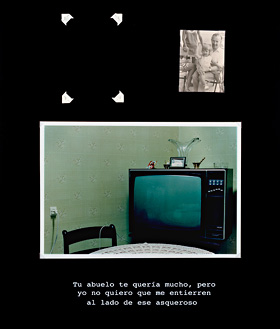 Yolanda del Amo
Yolanda del Amo
Del Amo mimics pages of a photographic album in her series of mounted digital C-prints, “My Little One Comes First.” Juxtaposing vintage images and vernacular sayings from her Spanish grandmother with her own contemporary compositions, del Amo creates a true album of the everyday, aptly strewn with troublesome memories and anticlimactic moments. Ultimately, it is, and was (her grandmother has since passed away), a dialogue between two generations and a personal tribute. The sometimes-bitter truths of her grandmother’s observations speak to what we reveal versus what we conceal in such a format. Her advice has been carefully worded and translated, then captured on a black background using a font similar to that of an old typewriter. A personality and story line emerge after reading several (“There’s a man in my building who keeps asking for a picture of me, but I don’t give photographs to anybody, much less to some guy who can’t be more than 70”). On what can be read as the last page, a photograph of a simple interior is placed next to an image of del Amo as a child. The text announces: “Your grandfather loved you very much, but I don’t want to be buried next to that bastard.” One photograph has been removed; the empty photo corners literally and symbolically serve as the only trace.
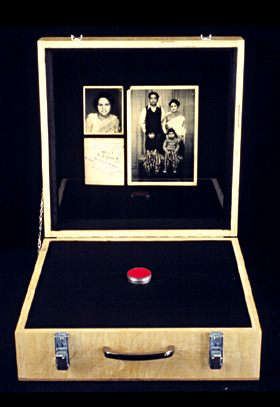 Priya Kambli
Priya Kambli
When Kambli moved from India to America in 1993, she could take only what would fit into one suitcase. Her “Suitcase Series” deals with this physical and mental move, and the attendant intellectual editing of snapshots, items, and ultimately memory. Each constructed case deals with a different theme and corresponds to a different hue, incorporating objects and photographs with intricate artisanship. These memory objects and personal relics reference vintage vernacular objects often produced for the home as well as domestic handiwork. Displayed open, the silk-lined boxes also recall early cased photographs in material and color. In Red, a top is situated above a family photograph sewn over with a spiral pattern, mimicking the trajectory of the spinning toy. This act symbolically stitches her memory back together again and also obscures it. Kambli utilizes many objects and items that reference the body or stand for a person or entity (common additions to vernacular photographic items): a family bracelet in Orange; a governmental ID photo paired with a small tin of sindoor (the red pigment applied to the parted hair of a married woman) in Black; and a personnel counter in Black 2. These embellished artworks allude to the tactile nature of the vernacular—displaying the touch of the artist in addition to begging to be touched.
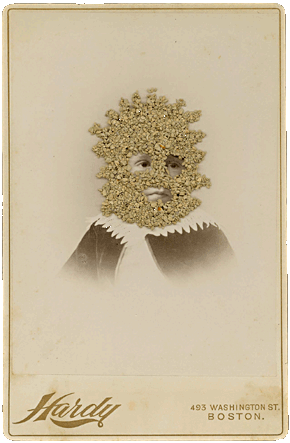 Joseph Heidecker
Joseph Heidecker
Heidecker finds vintage portraits at flea markets and estate sales to which he adds a variety of unexpected elements having domestic associations. These once-known persons have lost their identity upon entering the market, and, through a sort of subversive method of handwork turned on its head, he assigns them a new one. (The act appears all the more personal in the 19th century cabinet cards that bear handwriting of the family or the stamp of a studio.) The photographs (and people) become raw materials and take on a new life as a sort of rude ready-made assemblage. His touch straddles high and folk art, the efforts seem raw in their intention—likened to a child taking a crayon to a picture or a jilted lover cutting a person from a snapshot—but exquisite in their execution, resembling the delicate addition of paint to a cased portrait or tintype. In one of his enlarged, altered shapshots, he covers the body of a trumpet player with plastic sequins and pins (a synaesthetic effect?). In another, person and surface is obliterated through the use of bleach and the addition of a new visage. The trace of the author is challenged and amended by Heidecker’s reclamation. The portrait becomes a muse for its eventual transformation as well as a means to enact post-modern defiance.
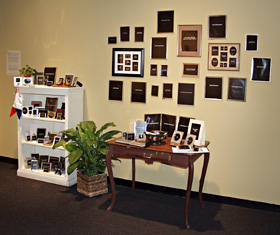 Susan E. Evans
Susan E. Evans
Two selections from Evans’s Saga series—site-specific installations of “a constructed idealized Americana family narrative”—are featured at the PRC, Kid’s Shrine and Wall Group. Each piece alludes to a different interior space and consists of white words on black backgrounds displayed in frames. These photographs, created by photographically printing the typed words, describe invented people and scenes. (Examples include, “Annie and Joey chopping wood at the cabin” and “Jack” in a gilt frame with a kneeling boy, cross, and angels.) The pictures are then set up to create and comment upon exaggerated domestic tableaux. Evans encourages each venue to locate furnishings and create spaces for which she provides the trinkets and trophies. In installing this work, I as curator imitate a domestic version of museum practice (I think back to how photographs are displayed in my parent’s home: clustered on the television, nestled on the end table, scattered down a hall). Ideas of the index and tracing figure in the photographs as well as several accessories (bronzed baby shoes and the quintessential kindergarten art project, the plaster of paris handprint). In Evans’s photographs, however, there is no person or object in front of the camera. Swimming against a deep sea of black, the words in Saga could be read as epitaphs. Evans literally gives us a blank slate—names, descriptions, and our own imagination serve to animate the fictitious extended nuclear nexus.
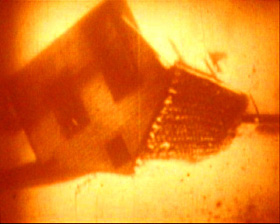 Louise Bourque
Louise Bourque
In making her experimental films, Bourque uses images from her family’s old home movies as well as other found footage and footage she shot, which she then alters with various unorthodox techniques and processes involving the direct manipulation of film’s photographic emulsion (low-tech contact printing, hand-processing and coloring, bleaching, scratching, and even burying). The resulting short films (four of which are on display in the gallery) touch on themes of memory and loss. Going Back Home, a 20-second piece shown twice to a found music box soundtrack, for example, incorporates snippets of vernacular films (a well-known film from the FSA era, educational reels on fire safety, and generic footage of collapsing dwellings). Set to the scratchy hiccups of a skipping 78 record featuring a 1903 recording of Caruso singing “A Dream,” Imprint focuses obsessively on the image of Bourque’s ancestral home. To create the piece, she made some 25 print copies of a small section of a home movie and then applied a different technique to each, from batik style toning using lip balm to hole punching and repasting. The latter effect recalls a magnifying glass traveling erratically across the screen as if to remember, to process, to understand. As Edward Crouse observed of Imprint in the San Francisco Bay Guardian, "[Bourque] throttles and exhausts a particular memory-image […] and traces its corrosion and dissolution even as it intensifies it physically." In these films, I feel, ideas of the domestic and the home are strangely venerated and harshly challenged simultaneously.
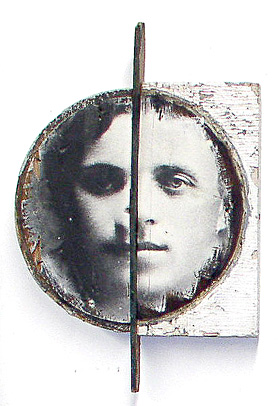 David Prifti
David Prifti
After his narrative color images of his family were included in the Museum of Modern Art’s seminal exhibition Pleasures and Terrors of Domestic Comfort (1991), Prifti’s work evolved toward mixed media, yet kept the same genealogical focus. Old and new family photographs now adorn decayed and decrepit found materials through Prifti’s use of liquid photographic emulsion. Everyday images become haunting, transformed as such into ancestral artifacts and memory talismans. Again and again, the meeting or parting of faces and family surfaces in his creations. The fragments in their nature, appearance, and methodology speak of how memory is constructed, deconstructed, obstructed, and reconstructed. (One is reminded of ancient roman ruins, the faces of long dead peering from shards and debris.) Prifti’s work shares kinship with two ethnic sculptural forms: African minkondi and Mexican fotoescultura. Also known as nail figures, minkondi were sacred carved figures into which nails were driven as a form of oath taking. Dating primarily from the 1920s to 1980s and made by traveling salesmen, fotoescultura consisted of hand colored photographs on carved bases of wood. In both of these objects, sacred and secular unite. An observation by Monica Garza in an Afterimage essay could equally refer to Prifti’s photo-objects: “…the fotoescultura is not just a portrait, but an icon situated within a portable shrine that demands its caretaker to interact with it in a way that is different from one’s relation to any traditional photograph.”
 Nancy Dudley
Nancy Dudley
While at a flea market, Dudley came across an amateur astronomer’s notebook, which later turned out to be the efforts of a distant relative. Using discarded Polaroid paraphernalia or ruined prints as a substrate, she digitally composites selections from this enigmatic ledger, including scientific diagrams that transform into allegory, along with photographs of herself as a child and typewritten phrases from old letters. Heightened by their presentation as lush Iris prints, the layered results recall a chalkboard or journal in aesthetics and principle—a tabula rasa for personal and constructed recollection. Might this space—a dark, subtly rainbow-colored void—be the realm of forgetting, while the images, diagrams, and letters, be the realm of the concrete (or vice versa)? That her substrate is a mistake, throw away, or by-product of an instantaneous process, makes it all the more poignant and mysterious. Mimicking the piecemeal nature of an album and modus operandi of memory, Dudley presents the viewer with fragments, small fractions of a whole she doesn’t even know. With the little girl serving as our “guide or witness,” we observe, notice patterns, sleuth, just as we might if we happened upon a collection of ephemera. The result is cumulative and poetic. Photoshop and Polaroid become mnemonic devices in the creation of a 21st century scrapbook.
A New Kind of Vernacular?
The death of photography in the face of digital has been an ongoing lament in the canon of photographic history. Some of the first dins of the dirge were heard in the plethora of histories, catalogues, and coffee table books produced for photography’s sesquicentennial in 1989. At the same time critics commemorated photography’s arguable “birth” in 1839, digital photography loomed like a sinister rogue, a repeatedly cited threat to photography’s ontological status even as digital imaging technology itself was only in its infancy. Notwithstanding this era’s longing for past epochs and the artworld’s parallel penchant for antique photographic processes and appropriation, are we to agree with Joel Smith’s conclusion in his essay, “Roll Over: The Snapshot's Museum Afterlife” in Afterimage?: “Not unlike the skipping, popping, long-playing vinyl record, an object of fetishistic nostalgia among listeners raised on compact discs, the snapshot with its blurs and thumbprints is taking shape as the most potent emblem of a dying medium’s historicity.”
Today, the giants in the consumer photo industry seem to have acquiesced to the digital gods, and now fear (or promote?) the loss of the analog object altogether. In the window of my local MotoPhoto is a poster encouraging people to print their digital photos, to make them physical, to make them “real”. I too am guilty of this. Hundreds, if not thousands, of digital photos lie hidden away in my hard drive. Occasionally, I peruse them, but for the most part they remain unused and unseen, seemingly spent of their usefulness in the act of taking them. I pressed the button, and I did not do the rest. Smith continues, “Emailed picture files are our era’s true ephemera, unlikely ever to graduate into physical form for the accidental benefit of later generations; even those that are printed will lack the archival hardiness of 70-year old drugstore prints.” Perhaps the artists in this exhibit can serve as our guide in considering a new kind of 21st century vernacular as well as a hybrid photographic genre. More importantly, they can encourage us to revisit and celebrate our own vernacular photographs.
Selected Bibliography
Batchen, Geoffrey, guest editor, Afterimage, Special Issue on Vernacular Photography, Rochester, NY: May-June 2002.
Batchen, Geoffrey, Each Wild Idea: Writing, Photography, and History, “Vernacular Photographies,” Cambridge, MA: MIT Press, 2001.
Batchen, Geoffrey, Forget Me Not: Photography & Remembrance, New York and Amsterdam: Princeton Architectural Press and Van Gogh Museum, 2004.
Barthes, Roland, Camera Lucida: Reflections on Photography, translated by Richard Howard, New York: Hill and Wang, 1981.
Kaplan, Daile, Pop Photographica: Photography’s Objects in Everyday Life, 1842-1969, Toronto, Canada: Art Gallery of Ontario, 2003.
Klochko, Deborah and John Turner, Create and Be Recognized: Photography on the Edge, San Francisco, CA: Yerba Buena Center for the Arts and Chronicle Books, 2004.
Nickel, Douglas, Snapshots: The Photography of Everyday Life, 1888 to the Present, San Francisco, CA: San Francisco Museum of Modern Art, 1998.
Smith, Joel, “Roll Over: The Snapshot's Museum Afterlife,” Afterimage, Rochester, NY: September-October 2001.
Wolfe, D. J. essay in Close to Home: An American Album, Los Angeles, CA: The J. Paul Getty Museum, 2004.
Please visit the PRC’s Aaron Siskind library for a special display devoted to publications on vernacular photography, including selections by BUAG’s conference panelists.